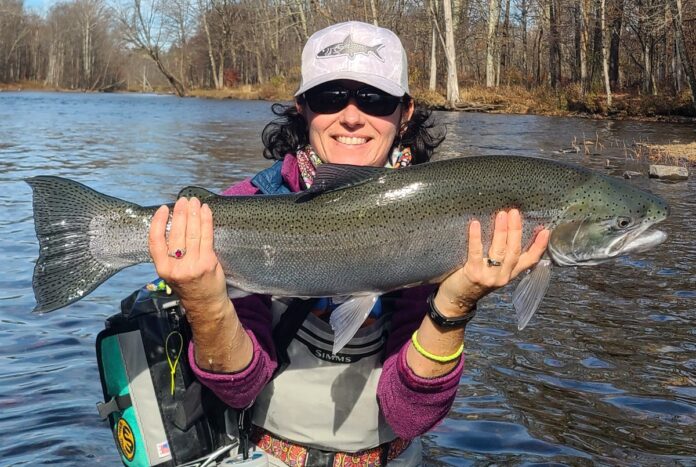The water rushed around Stacy’s legs, trying to pull her in as she waded into the river. She pushed forward choosing her spot, visualizing her strategy.
She chose the top of the pool, but it was angry, as if it were trying to dislodge every rock from the river bed.
I set up below her where the water was happy, slowly dancing, then resting, before its rage builds and quickens again. I started in the middle and worked my way down to the tail, thinking I would have better luck.
Fish push up through the fast water then rest and hold in the slower water, oftentimes feeding before moving to the next raging run. I had zero luck moving back and fourth, changing flies and covering 75 percent of the pool. Stacy stayed put and worked the fast water.
As I look up river to see how Stacy is doing …
Let’s pause for a little backstory.
We are fishing the famous Salmon River in New York, where we are often sitting in the dark at 4 a.m. on the side of the river to secure our spot for the day. We were fortunate enough to have nine days out there this time, so that gave us the opportunity to wander and explore as much as we wanted.
This particular day we slept in, did laundry at a laundromat, had breakfast and simply found a place to fish. We decided to hike downriver until we saw no people. It was close to a mile before we found our spot.
The run was fast and shallow, slowing into a long, deep pool, then speeding up and shallowing once again. It just seemed perfect. As our steps picked up in excitement our hearts dropped as a husband and wife stepped out of the woods and headed to the same pool.
Thankfully, it was short lived. We shared the pool for 20 minutes and they moved on. The pool was ours.
Stacy chose a black and copper stone fly that day. It was a color combo we hadn’t added to our fly box until the night before. We were about to see just how effective it could be.
As I look upriver to see how Stacy is doing, I see a steelhead trout porpoise through the water, too heavy to cut through the current. I instantly reel up and get myself out of the water. My heart is racing and my hands are shaking.
It takes two people to land a fish of this size, which means the pressure is on. I wrestle with the net, pulling it from my sling pack as I race toward the beast. We knew our odds of landing it would greatly decrease if it made its way downriver, so it was Stacy’s goal to keep it in the pool.
No huge runs, just small, short bursts followed by a short hang in the current. Stacy played it perfectly, keeping just enough pressure on it. Instinctually you want to keep the line super tight but it’s better to keep light pressure and let the tip of the rod actually fight the fish, flexing and bending with every surge and rest.
The fish comes to the net several times, and each time it would see the net and move back to the middle of the pool. The longer you fight it, the greater the chance the hook will find its way out. Each time the fish would get close, Stacy would move back out of the water.
This kept the steelie’s runs short and allowed her to keep the fish from surging into the current. She slowly worked the fish to the riverbank and the head into the net.
This was a fish of a lifetime! The massive beast taped out at 32 inches with an equally massive girth — a heavy fish! We hoot and hollered, celebrating her success. Fish of this size tend to get away, but everything lined up and Stacy landed a trophy.
More articles from the BDN
Credit: Source link































